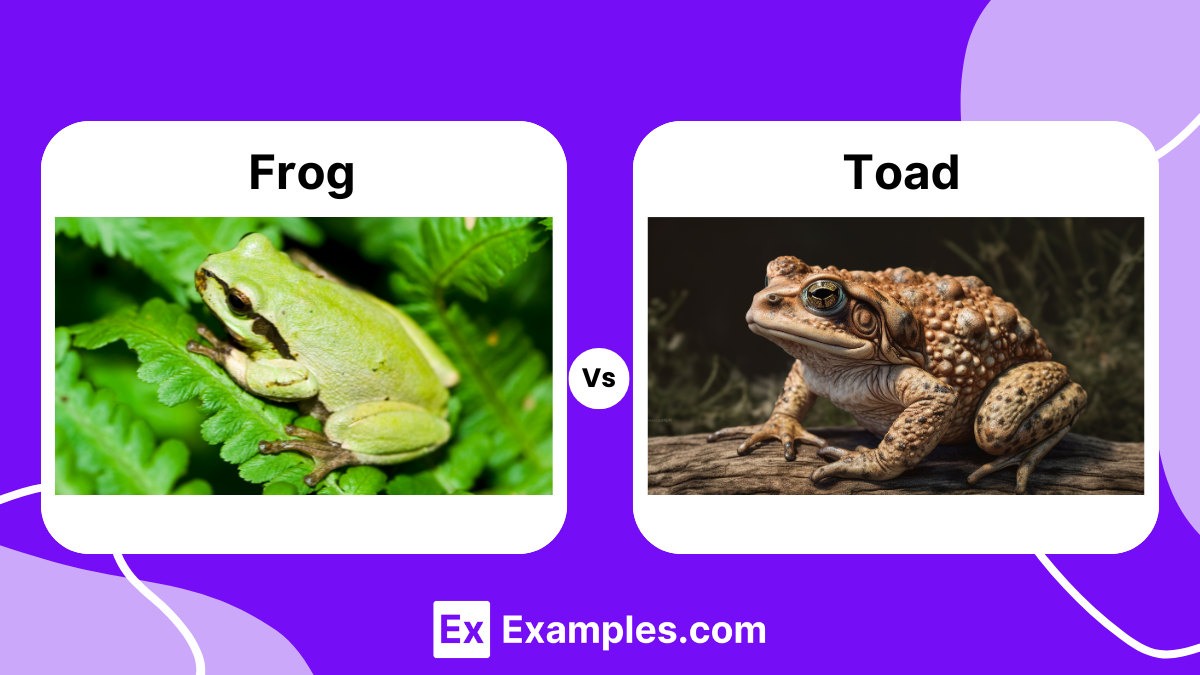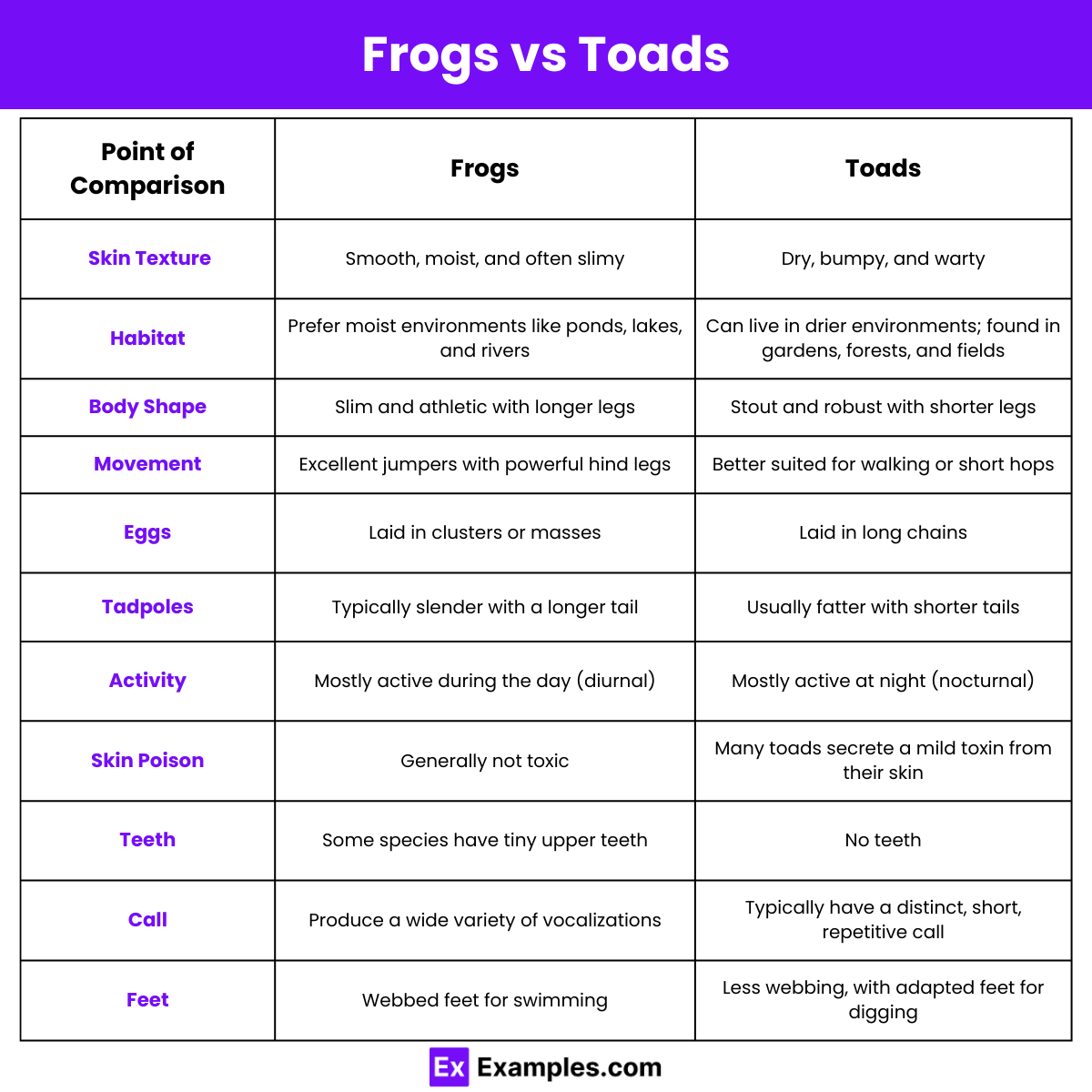Which of the following typically has smooth and moist skin?
Toad
Frog
Lizard
Salamander


Frogs and toads, often mistaken for one another, display distinct differences despite their similarities. These amphibians belong to the same order, Anura, but they diverge in appearance, habitat, and behavior. Understanding the contrasts between frogs and toads enhances our appreciation of their unique roles in ecosystems. In this article, we will explore the key differences between frogs and toads, focusing on their physical characteristics, habitats, and lifestyles. By the end, you will easily distinguish these fascinating creatures and appreciate their unique adaptations.
Frogs are fascinating amphibians belonging to the order Anura. These creatures are found on every continent except Antarctica and are known for their distinctive jumping abilities, croaking sounds, bulging eyes, and slimy skin. Here’s a closer look at the biology, habitat, and lifecycle of frogs.
Body Structure:
Physiology:
Frogs are highly adaptable and can live in a variety of habitats, including:
Frogs undergo a unique metamorphosis during their lifecycle:
Ecological Role:
Environmental Indicators:
Frogs face numerous threats, including:
Toads are amphibians belonging to the family Bufeniode. Although they share many similarities with frogs, toads have distinctive characteristics that set them apart. Here’s an in-depth look at their biology, habitat, lifecycle, and ecological importance.
Body Structure:
Physiology:
Toads are versatile and can be found in various habitats:
Toads undergo a similar lifecycle to frogs, with a few differences:
Ecological Role:
Environmental Indicators:
Toads face several threats, including:

| Feature | Frogs | Toads |
|---|---|---|
| Skin Texture | Smooth, moist | Dry, warty |
| Body Shape | Slim, streamlined | Stout, squat |
| Legs | Long, powerful for jumping | Short, adapted for walking/hopping |
| Movement | Excellent jumpers | Prefer to walk or hop |
| Habitat | Prefer moist, aquatic environments | Thrive in drier habitats |
| Eggs | Laid in clusters | Laid in long chains |
| Tadpoles | Slender with longer tails | Stout with shorter tails |
| Parotoid Glands | Absent | Present behind eyes, secrete toxins |
| Eyes | Bulging, often bright-colored | Less prominent, usually golden or brown |
| Vocalization | Croak or ribbit, usually near water | Mellow, deep trills |
| Teeth | Maxillary teeth in upper jaw | No teeth |
| Metamorphosis | Rapid growth and transition | Slower development |
| Respiration | Rely on moist skin and lungs for breathing | Primarily use lungs |
| Coloration | Bright, varied colors | Usually brown, gray, or olive |
| Defensive Behavior | Jump away from predators | Puff up body, secrete toxins |
Frogs and toads, often mistaken for one another, share many similarities due to their close taxonomic relationship. Here are the key similarities between these amphibians:
| Characteristic | Frogs | Toads |
|---|---|---|
| Skin Texture | Smooth and moist | Rough and dry |
| Leg Strength | Long, strong legs for jumping | Shorter legs for short hops |
| Preferred Habitat | Near water bodies | Often found further from water |
| Egg Laying | Clusters in water | Strings in water |
| Skin Secretions | Toxin secretion for defense | Toxin secretion for defense |
| Breathing | Through skin and lungs | Through skin and lungs |
| Vocalization | Distinct calls during mating season | Distinct calls during mating season |
| Metamorphosis | Tadpole to adult frog | Tadpole to adult toad |
Frogs have smooth, moist skin and prefer aquatic habitats, while toads have dry, bumpy skin and thrive in drier environments.
Frogs have long legs for jumping and smooth skin, whereas toads have shorter legs for walking and bumpy skin.
Both are carnivorous, eating insects and small invertebrates, but frogs often consume more aquatic prey compared to toads.
No, frogs belong to the family Ranidae, and toads belong to the family Bufonidae.
Frogs typically live 2-10 years, while toads can live up to 15 years or more in the wild.
While they can coexist in some habitats, frogs prefer moist environments, and toads prefer drier conditions.
Both lay eggs in water, but frog eggs are laid in clusters, while toad eggs form long chains.
Toads often have parotoid glands that secrete toxins, making them more poisonous than most frogs.
Yes, frogs typically croak, while toads produce a more continuous, trilling sound.
Frogs are better climbers due to their suction-cup-like toe pads, unlike toads.
Text prompt
Add Tone
10 Examples of Public speaking
20 Examples of Gas lighting
Which of the following typically has smooth and moist skin?
Toad
Frog
Lizard
Salamander
What is a common habitat difference between frogs and toads?
Frogs are usually found in dry environments, while toads prefer wet areas
Toads are typically found in trees, while frogs live on the ground
Frogs are commonly found near water, whereas toads can live in drier habitats
Toads are found in aquatic environments, while frogs prefer land
Which of the following describes the typical reproductive behavior of frogs?
They lay eggs in water and undergo a complete metamorphosis
They lay eggs on land and have no metamorphosis
They lay eggs in trees and directly hatch into adults
They lay eggs in dry soil and skip the larval stage
What is a distinguishing feature of toads compared to frogs?
Toads have smooth skin with no warts
Toads generally have longer legs
Toads have bumpy, warty skin
Toads are more aquatic than frogs
In terms of body shape, which is generally true about frogs compared to toads?
Frogs have shorter legs and a more robust body
Frogs have a more elongated body and longer legs
Frogs have a wider body and shorter legs
Frogs have no difference in body shape compared to toads
How do frogs and toads typically differ in their call sounds?
Frogs make a croaking sound, while toads make a high-pitched trill
Frogs make a high-pitched trill, while toads make a croaking sound
Both frogs and toads make similar calls
Frogs and toads do not make any calls
Which species is more likely to exhibit a more pronounced protective coloration or camouflage?
Frogs
Toads
Both frogs and toads equally
Neither frogs nor toads
What is a common defensive mechanism of toads?
They secrete a toxic substance from their skin
They use bright colors to deter predators
They emit a high-pitched sound to scare away predators
They play dead when threatened
Which statement is generally true about the diet of frogs and toads?
Frogs primarily eat insects and small invertebrates, while toads eat larger prey
Frogs and toads have identical diets, focusing on plants
Frogs mainly eat plants, while toads primarily consume insects
Frogs are herbivores, while toads are carnivores
How do the eggs of frogs and toads typically differ?
Frog eggs are laid in single strings, while toad eggs are laid in clusters
Frog eggs are laid in clusters, while toad eggs are laid in single strings
Both frogs and toads lay eggs in the same pattern
Frog eggs are always laid on land, while toad eggs are laid in water
Before you leave, take our quick quiz to enhance your learning!

